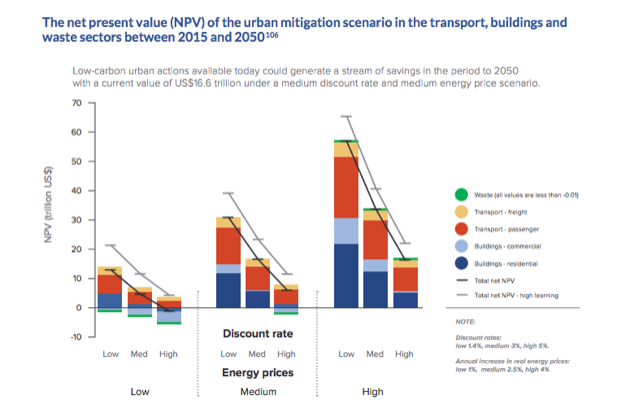New Climate Economy Report (2015) Showcases the Role of Transport Sector in Achieving Low Carbon Economic Growth
‘The 2015 New Climate Economy Report’, published by The New Climate Economy, identifies ten key areas of opportunity for stronger climate action which will also bring significant economic benefits. Transport is listed under two of the ten key areas to facilitate a low carbon, sustainable economic growth. Together, it is estimated that these could achieve at least 59% and potentially as much as 96% of the emissions reductions needed by 2030 to keep global warming under 2°C.
2015 is a year of unprecedented opportunity. This year’s landmark intergovernmental conferences – the International Conference on Financing for Development in Addis Ababa in July, the United Nations Summit to adopt the post-2015 Sustainable Development Goals in New York in September, the G20 Summit in Antalya in November, and the UN Climate Change Conference (COP21) in Paris in December – have the potential to advance a new era of international cooperation which can help countries at all income levels build lasting development and economic growth while reducing climate risk.
The report indicates that infrastructure investment – in transport networks, power plants and transmission systems, buildings, water and telecommunication systems – is a crucial driver of development, providing critical services and raising the overall productivity of the economy.
The Commission’s 2014 report, Better Growth, Better Climate estimates that the world will need US$90 trillion of infrastructure investment in 2015–30 (an average of US$6 trillion a year), concentrated in cities, energy and land use systems. But it points out that the choice of infrastructure is critical. Many forms of infrastructure, including roads, public transport systems, power plants, water management systems and urban buildings make significant contributions to GHG emissions, and they are also particularly vulnerable to the rising incidence of extreme weather events. If long-lived investments are made without attention to wider impacts, such as on energy security, air pollution, GHG emissions and resilience to climate damage, the world will become locked into a carbon-intensive development path with severe risks to both growth and climate. Building low carbon infrastructure would require not much more capital, perhaps an additional US$4 trillion of investment (around 5% more), and this could well be largely or completely offset by longer term operational savings on fossil fuel costs.

Passenger and freight transport plays a integral role in realizing the urban mitigation scenario between 2015 and 2050 (source: The New Climate Economy)
Transport is listed under two of the ten areas of opportunity:
Key Area 1: Accelerate low-carbon development in the world’s cities
The report states that all cities should commit to developing and implementing low-carbon urban development strategies by 2020, using where possible the framework of the Compact of Mayors, prioritizing policies and investments in public, non-motorized and low-emission transport, building efficiency, renewable energy and efficient waste management.
Key Area 7: Galvanize low-carbon innovation
The Commission suggests that emerging and developed country governments should work together, and with the private sector and developing countries, in strategic partnerships to accelerate research, development and demonstration (RD&D) in low-carbon technology areas critical to post-2030 growth and emissions reduction.
Key technologies to avoid lock-in of carbon-intensive infrastructure, including buildings, electricity networks and transport systems, would be one of the key priority areas for low-carbon cooperative innovation.

Long-term energy efficiency economic potential by sector (source: The New Climate Economy)
The report also points out that many cities are also expanding and improving mass transit, embracing bus rapid transit (BRT) in particular, which costs, on average, one-tenth as much as metro rail transit. Infrastructure that makes cycling easier and safer improves public health by promoting physical activity and reducing air pollution and vehicle accidents. Moreover, cycling is a low-cost option that can enhance mobility for the urban poor. Cities are also discovering the benefits of building distributed energy systems based on small-scale renewables, particularly as costs have dropped sharply in recent years.
For more information, please go here.